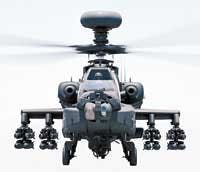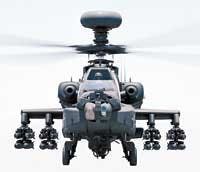Lockheed Martin uses Evans capacitors for Arrowhead
Engineers at Lockheed Martin Missiles and Fire Control in Orlando, Fla., needed power capacitors for the Arrowhead electro-optical fire-control system on the U.S. Army’s AH-64 Apache attack helicopter.
They found a solution with Evans Capacitor Co. in East Providence, R.I. Under a $1 million contract, Evans will supply capacitor banks for Arrowhead, a targeting and pilotage system for Apache crews to fly in day, night, and adverse-weather environments. Arrowhead’s forward-looking infrared (FLIR) sensors use advanced image-processing techniques to give pilots the best possible resolution to avoid obstacles such as wires and tree limbs during low-level flight.
In January, Army planners awarded Lockheed Martin a $247 million contract to build 97 Arrowhead systems for domestic and foreign military users. These new deliveries will begin in July 2006. The Army’s first unit equipped with Arrowhead will be fielded in June 2005. The Army intends to buy 704 Arrowhead systems to outfit its AH-64 Apache fleet by 2011.
The capacitor banks consist of a number of tantalum-encased, electrolytic-electrochemical Evans Hybrid Capacitors specifically rated for this application. For more information, see www.evanscap.com.
Integrated CircuitsActel processor drives image-recognition engine
Engineers at General Vision in Petaluma, Calif., needed a processor for their CogniSight image-recognition engine. They found a solution with the ProASIC Plus from Actel in Mountain View, Calif. The single-chip ProASIC Plus is a flash-based field-programmable gate array (FPGA).
CogniSight can synthesize the color, shape and texture of visual objects, learn these signatures with a set of parallel silicon neurons (NeuroMemory), and then recognize identical or similar objects to produce a response. This “generic image-recognition” technology targets applications in remote sensing, automated security/sentry, defense video tracking, image-content mining and human system interfacing, as well as medical imaging and factory automation.
“While we have used FPGAs in earlier designs, the distributed RAM block feature in Actel’s ProASIC Plus family was very important for our next-generation image recognition controller and a prime reason for its selection,” says Guy Paillet, partner in General Vision.
“And because the controller, which performs the pixel preprocessing for our neural-network chips, needed to accommodate a range of image-recognition applications, it was important that we were able to scale the memory blocks yet keep the FPGA package size and I/O the same, from 150,000 to as many as 1-million gates.”
For more information, see www.actel.com.
ComputersAir Force uses Cray computer for surveillance
Engineers at the U.S. Air Force’s Maui High Performance Computing Center (MHPCC) on the Hawaiian island of Maui needed a powerful computer to perform space surveillance and image processing.
They chose an XD1 supercomputer from Cray Inc. in Seattle. The order is part of a $23 million contract from the U.S. Department of Defense High Performance Computing Modernization Program (HPCMP).
MHPCC is an Air Force Research Laboratory in the Directed Energy Directorate. Researchers at their Maui Space Surveillance Site (MSSS) will use the Cray XD1 system to gather data on near- and deep-space objects at night or in daylight. The computer uses 288 AMD Opteron processors to generate peak performance of 1.4 trillion calculations per second.
“The Cray XD1 supercomputer is ideally suited for handling the vast quantities of data and analysis driven by our space surveillance activities,” says Major Kevin Benedict, Director of MHPCC, “We look forward to a mutually beneficial relationship with the new Cray Inc.”
The XD1 uses direct-connect-processor (DCP) architecture, which removes PCI bottlenecks and memory contention to deliver sustained performance; it boasts the lowest latency of any current HPC system, with MPI latency of 1.8 microseconds in measured tests conducted using the Ohio State MPI benchmark. For more information, see www.cray.com.
SoftwareAnteon picks Harris to manage Army training video
Engineers at Anteon International, Fairfax, Va., needed a video management system for the Objective Instrumentation Systems Program at the U.S. Army’s Combat Training Center.
They chose an integrated video-content management and distribution system from Harris Corporation’s Broadcast Communications Division in Cincinnati.
Harris will provide a system that can digitally transport, ingest, store, add metadata, analyze, and archive large quantities of video produced during training exercises. The video will come from more than 60 sources, including night-vision cameras, handheld camcorders and fixed cameras. The resulting excerpts will go to several devices, ranging from large, fixed-location theaters and mobile battleground theaters to portable laptop computers in the field.
The Harris Invenio enterprise-wide collaborative content-management suite will provide metadata tagging, search and retrieval, and the ability to add custom vocabulary to make the system friendly to end users. In addition, the project will use Harris NetVX high-speed connectivity for video networks, and Harris DataPlus WAN-based media management for real-time collection, scheduling and transfer of digital assets.
The project, led by Lockheed Martin Simulation, Training & Support, will deploy at the Army’s National Training Center at Fort Irwin, Calif. For more information, see www.broadcast.harris.com.
Test and MeasurementBoeing orders test center from Rohde & Schwarz
Engineers at Boeing in Chicago needed electromagnetic-compatibility (EMC) measurement equipment for the Agency for Defense Development (ADD) in South Korea. They chose Rohde & Schwarz of Columbia, Md., for a $20 million contract to deliver a turnkey Electromagnetic Test Center. Rohde & Schwarz will partner with ETS-Lindgren L.P. and MI Technologies to do the job.
The Electromagnetic Test Center will consist of a full-size aircraft test chamber, along with various support chambers, shielded rooms, system measurement equipment, lightning/EMP simulation, and training. This new test center-the first of its kind in South Korea-will give ADD the unique multifunctional capability to perform EMC measurements, antenna characterization, and lightning, electrostatic discharge, and electromagnetic pulse simulations.
Rohde & Schwarz makes test and measurement and communications equipment for RF test equipment, mobile radio, broadcasting, information security, and radio monitoring, location, and communications. For more information, see www.rohde-schwarz.com/USA.
SoftwareGeneral Dynamics picks Enea operating system for MUOS radio
Engineers at General Dynamics needed a real-time operating system for the U.S. Navy’s Mobile User Objective System. They found a solution with OSE from Enea Embedded Technology in Tempe, Ariz.
General Dynamics will use Enea’s OSE real-time operating system (RTOS) and development tools for use in a wireless satellite ground control system that General Dynamics is providing for the SPAWAR (Space and Naval Warfare Systems Command) Mobile User Objective System (MUOS).
MUOS is a narrowband tactical satellite communications system U.S. ground forces on the move. Slated to become operational in 2010, it would provide 10 times more throughput than the current system.
Lockheed Martin, acting as the prime contractor for the MUOS project, chose General Dynamics C4 Systems in Scottsdale, Ariz., to create the ground system interface between MUOS satellites and existing and future U.S. Department of Defense terrestrial communication networks. General Dynamics will use the OSE RTOS to provide the narrowband wireless connectivity needed to implement this secure ground and satellite network.
OSE is a compact, pre-emptive, memory-protected, multiprocessor RTOS optimized for distributed, fault-tolerant applications that demand the utmost in reliability, security, and availability. OSE enhances reliability by building a firewall between kernel and application processes that prevents errant or malicious processes from corrupting each other. OSE also provides automatic failure detection and supervision (health monitoring) of system processes and applications. For more information, see www.ose.com.
Board productsGoodrich picks Radstone processors for F-16
Engineers at Goodrich Corp. in Charlotte, N.C., needed processors for the Polish F-16 jet fighter Reconnaissance Program. They found a solution with Radstone Embedded Computing in Towcester, England.
Goodrich will use Radstone’s PowerXtreme PPC7D single-board computer, PMCGA3 graphics accelerator PMC, and PMCF2 CompactFlash PMC. All three components will go in the Poland Peace Sky F-16 Reconnaissance program.
“Radstone’s reputation for technical excellence and outstanding customer support is admired throughout the industry,” says John Stacy, director of engineering for Goodrich’s Surveillance & Reconnaissance Systems team. “Not only will they bring the levels of product performance and reliability that we’re looking for, but also experience and expertise that will add real value to the program. We’re looking forward to working with the Radstone team.”
Goodrich will provide the reconnaissance pod to the Polish Air and Air Defense Forces. The system features the Goodrich DB-110 dual-band, electro-optical/infrared LOROP (Long Range Oblique Photography) sensor, which can image targets at 30,000 feet at a standoff distance of 50 nautical miles.
The system will support NATO forces providing bomb-damage assessment and time-critical targeting. The Radstone equipment is for the DB-110 avionics to manage the reconnaissance systems and perform sensor control functions. For more information see www.radstone.com.
DisplaysNavy taps L-3 for helicopter display
Engineers at Naval Air Systems Command (NASC) at Patuxent River Naval Air Station, Md., needed cockpit displays for the CH-46E Sea Knight helicopter. They chose a solution from L-3 Communications Display Systems in Alpharetta, Ga.
L-3 has already delivered some displays; the new contract orders an additional 128 Actiview Model 550 Electronic Flight Indicators (EFIs) to replace the current CH-46E Horizontal Hover Situation Indicators (HHSIs).
Features include a 5.5-inch-diagonal high-resolution active-matrix liquid-crystal display (AMLCD), a high-brightness, high-performance backlight, and night-vision- goggle compatibility. Initial deliveries for this contract will begin in July 2005.
“The HHSI has been a big problem for CH-46E maintenance for many years,” says Ron Johnston, H-46 Avionics Systems project officer. “The old display was at the end of its life and there were no available spare parts for repair. This program office asked L-3 Display Systems to develop a replacement HHSI, and L-3 responded rapidly. Within seven months, L-3 Display Systems has delivered more than 85 units to the fleet Marine forces, and we now have spares readily available. Quick and accurate engineering, rapid delivery and improved reliability of the needed replacement systems have increased the readiness of the CH-46E fleet.”
For more information, see www.L-3Com.com/displays.
ComputersNavy uses Titan tools to share UAV video data
Engineers at the Naval Special Warfare (NSW) Command, San Diego, Calif., needed a tool to share images and video from unmanned vehicles with field personnel. They chose VideoScout from The Titan Corp. in San Diego.
With the vast amount of video data being generated by manned and unmanned vehicles, Navy leaders face a challenge in distributing that data and intelligence to personnel in the theater of operations.
So NSW will deploy VideoScout in Tactical Operations Centers to capture, encode, archive, search/retrieve, annotate, and transmit the video and images from unmanned vehicles. Then the system will relay relevant video via existing communications infrastructures, such as the Global Broadcast Service.
VideoScout is a portable, ruggedized commercial off-the-shelf system that includes Intelligent Video software and digital video and image processing boards. VideoScout’s software is a Windows-based application that allows users to capture video, add metadata such as GPS data and altitude, add annotations, and create still images.
The VideoScout ruggedized laptop is a Pentium mobile computer that meets MIL-STD-801F standards. The laptop’s magnesium casing and waterproof rubber keyboard withstand the environmental challenges of field operations, and it uses standard Windows operating system, Ethernet communications, and MPEG-2 compression. For more information, see www.titan.com.




